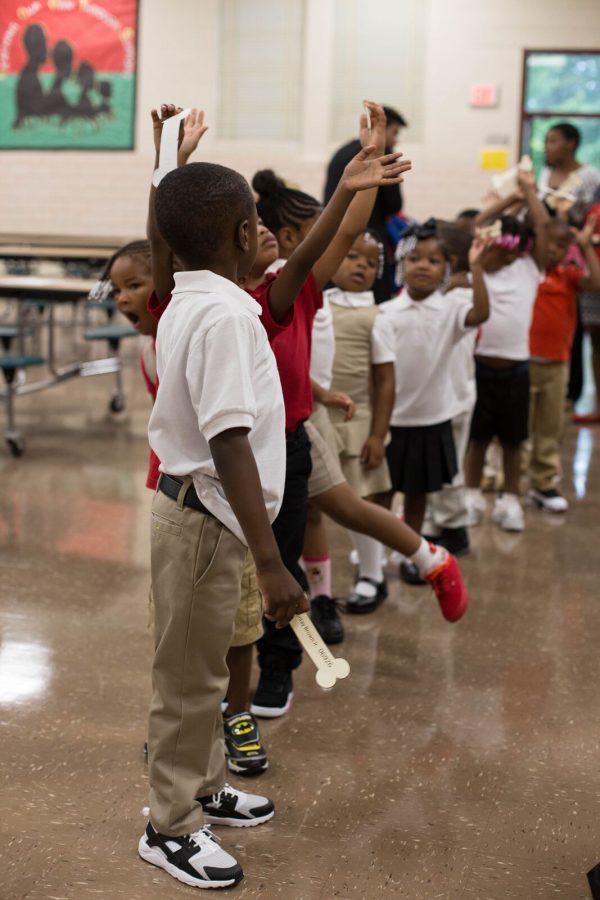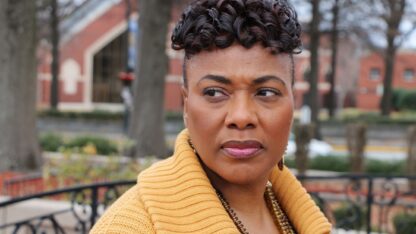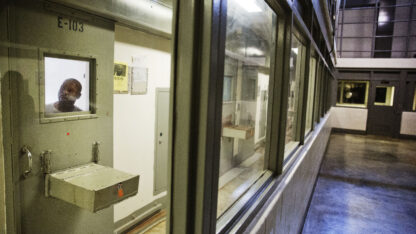Flat Shoals Teachers Try To Help Students Close The Gap

A Flat Shoals kindergarten student settles into her desk on the first day of school. The school has a “churn rate” of 54.4 percent, meaning more than half of the students will probably change schools at some point during the year.
Martha Dalton / WABE
Most of the students at Flat Shoals Elementary in Southwest DeKalb County come from low-income households, which means sometimes kids come to school tired, hungry or upset. The community is transient, meaning families move a lot. So, often students change schools a lot. The school has a “churn rate” of more than 50 percent. That can create challenges for teachers.
“You have a child sitting in front of you that you know they’re three, four years behind in reading, and you have to try to bring them up,” Flat Shoals Assistant Principal Amelia Jefferson said.
WABE is looking at how their efforts.
Sizing Up The Problem
During the first week of school, Flat Shoals teachers were already conducting informal assessments to see where their kids stood. Second-grade teacher Miranda Reid wanted to know how well her students could write. So, she asked them to write about a time they were afraid and what they did to overcome it.
She started with an example.
“It could be, like, when you got lost somewhere or when you couldn’t find a valuable someone gave you,” Reid said. “When I was young, I lost a ring that my aunt gave me, and I never got it back, and I was really sad about that.”
Almost immediately, a boy named Joseph piped up.
“So for my fear is I was scared I can’t camp, so my dad taught me how to do it, and so I start to get the hang of it until I face my fears,” he said.
Joseph had the talking part down. But the writing part was tougher. Reid tried to help him put his thoughts on paper.
“You can start it off by saying, ‘One day I was with my dad, and this is what happened’ or, ‘One day, I was by myself, and this is what happened,’” she told him.
The three other children in the group began writing. Joseph was still talking.
“One is o-n-e?” he asked Reid.
A few minutes passed. Joseph was struggling to spell simple words.
“This is how you spell dad – d-a-d?” he asked.
In the time Joseph has written a couple of words, a girl named Senaire has already written an entire story.
“One day, I was with my family and I was walking and I was holding my baby brother’s hand, and he let go, and I lost him,” she read aloud. “Then I was scared someone took him. Then luckily, I found him. I was so happy, so we went shopping.”
 ‘Differentiated Instruction’
‘Differentiated Instruction’
Here is the challenge facing teachers like Reid: they have to keep fast learners like Sinarie challenged, help struggling students like Joseph and teach every kid in between.
After the lesson, Reid said she was surprised Joseph struggled so much.
“I was a little taken aback when I saw that, and he’s not the only one,” she said. “I spoke with another teacher, and we were trying to figure out where to start with kids who may be that far behind.”
But Reid isn’t daunted by the task of helping Joseph improve. She uses ‘differentiated instruction’ to tailor her lessons.
“[We] work with different groups each day who need a little help, and that way I can also reach Senaire too because one of the days would be hers, where I could challenge her on a higher level,” Reid said.
Teachers at Flat Shoals differentiate their lessons often because they have a lot of kids who are behind. However, the school is making progress.
On the state test last year, Flat Shoals decreased the number of students in the lowest English/language arts level by 9 percent. The number of kids scoring in higher levels increased 8 percent.
In math, the gains were even bigger. The number of students in the lowest math level decreased by 19 percent last year. And kids scoring in higher math levels increased 21 percent.
This pleases teachers and administrators at Flat Shoals. However, they know it’s a small step on a long path ahead. Test scores at Flat Shoals are still well below the state average. That gap is tough to close when the majority of students come to school behind.
Assistant Principal Jefferson says there’s a silver lining.
“The one good thing about the state is it’s a growth model, so as long as a child is growing, we’re good,” she said.
That means as long as students show improvement, the school is headed in the right direction.
This story is part two of three exploring how teachers at Flat Shoals are trying to help their kids beat the odds. Part one focused on the challenges teachers face in the classroom. Part three will focus on school leadership and community involvement.








